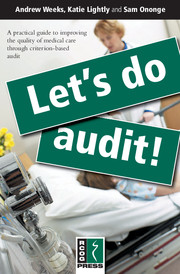 Let's Do Audit!
Let's Do Audit! Book contents
- Frontmatter
- Contents
- Acknowledgements
- Introduction
- Lesson 1 An introduction to clinical audit
- Lesson 2 Problem identification
- Lesson 3 Setting standards and establishing criteria
- Lesson 4 Measuring current practice
- Lesson 5 Analysing the data and comparing practice with agreed criteria
- Lesson 6 Implement change and re-audit
- Conclusion – let's do audit!
- References
- Appendix. Worked examples of audits
- Glossary of terms
- Index
Lesson 5 - Analysing the data and comparing practice with agreed criteria
Published online by Cambridge University Press: 05 July 2014
- Frontmatter
- Contents
- Acknowledgements
- Introduction
- Lesson 1 An introduction to clinical audit
- Lesson 2 Problem identification
- Lesson 3 Setting standards and establishing criteria
- Lesson 4 Measuring current practice
- Lesson 5 Analysing the data and comparing practice with agreed criteria
- Lesson 6 Implement change and re-audit
- Conclusion – let's do audit!
- References
- Appendix. Worked examples of audits
- Glossary of terms
- Index
Summary
Once you have collected the information, the ‘raw data’, on your audit pro forma, you need to bring all the data together and organise it. Then, use some simple mathematics such as averages, percentages and totals to summarise it so that it can be easily understood and used. You can then compare this with the audit criteria and standards that you created previously (see lesson 3).
Step 1 – Gather and organise the data
First, make sure that you have all of the pieces of paper and computer files that contain the raw data. If you are missing any parts of the data, try to find them now or it can confuse you later during your analysis. If access to a computer is available, then the data can be put into a table so they are clear and the information is easy to manipulate. This is especially important when there are large patient numbers. Whether you are putting the information into the computer or not, be sure to number your cases with your own audit number, so you can easily identify each patient. For example, if you have 25 cases, number the paper or the first column of the table 1–25 in ascending numerical order and then you can remove the personal identifying information such as hospital number and date of birth from the case.
- Type
- Chapter
- Information
- Let's Do Audit!A Practical Guide to Improving the Quality of Medical Care through Criterion-Based Audit, pp. 37 - 46Publisher: Cambridge University PressPrint publication year: 2010


